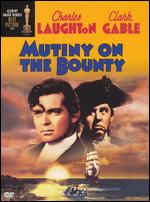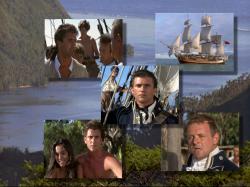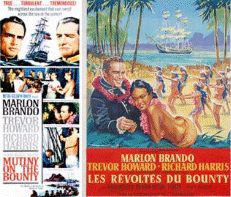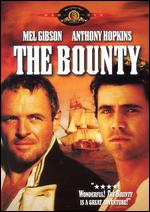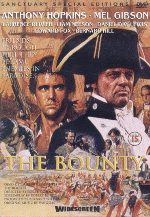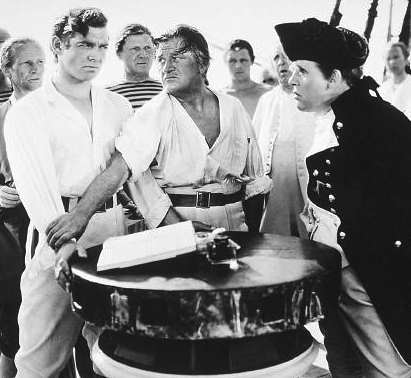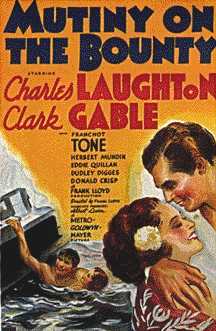|
MUTINY ON THE BOUNTY
|
|||||||||||||||||||||||||||||||||||||||||||||||||||||||||||||||||||||||||||||||||||||||||||||||||||||||||||||||||||||||||||||||||||
|
Mutiny on the Bounty (1935) is one of the best nautical adventure films of all time and one of MGM's greatest classics. I watched this film as a boy and it was indelibly imprinted in my mind. The rousing, 18th century story of the Bounty's mutiny, directed by Frank Lloyd, was adapted from the first two volumes of the Charles Nordhoff-James Norman Hall 1932 best seller, The Bounty Trilogy (composed of Mutiny on the Bounty, Men Against the Sea, and Pitcairn Island).
Mutiny on the Bounty 1935
For authenticity, the film was shot on location in the South Pacific's Tahiti, as well as on Catalina Island, Santa Barbara, and in MGM's Culver City studios, over a period of three months. The over-budget (about $2 million) MGM film was the studio's most expensive production since Ben-Hur: A Tale of the Christ (1926), but it was also the highest-grossing film of 1935 (at $4.5 million).
It was the first remake to win Best Picture (it was a remake of In the Wake of the Bounty (1933) starring Errol Flynn as Fletcher Christian). It was nominated for a total of eight Academy Awards, and its sole Oscar was for Best Picture. It was very unusual that the profitable film received no other Oscars than Best Picture (two other earlier MGM productions had done the same thing - Broadway Melody (1928-29) and Grand Hotel (1932)). The other seven nominations included three Best Actor nominations (Clark Gable, Charles Laughton, and Franchot Tone, who split the vote and gave the award to Victor McLaglen for The Informer) - a unique accomplishment (although Tone's performance was more like a supporting role, but the awards category hadn't been created yet), Best Director (Frank Lloyd), Best Screenplay (Talbot Jennings, Jules Furthman and Carey Wilson), Best Film Editing (Margaret Booth), and Best Score.
Charles Laughton, who had won the Best Actor Oscar for The Private Life of Henry VIII (1933), gave an exaggerated portrayal of the duty-obsessed, cruel and arrogant Captain Bligh - he made the character one of the screen's most memorable and abusive villains. [The first choice for the Bligh role was Wallace Beery.] Virile Clark Gable, who had won the Best Actor Oscar the previous year for It Happened One Night (1934), took the secondary role as the fair-minded First Mate Fletcher Christian, although he was reluctant to wear silly-looking breeches, sport a sailor's pony-tail, and shave off his mustache. With his performance, he solidified his status as one of the leading actors of the 30s.
The screenplay departed from some of the facts of the true event by romanticizing the cavortings of the 'beefcake' crew with the Tahitian native women, and by distorting the historical record with a denouncement and snubbing of the contemptuous, malevolent Bligh at the conclusion of the court-martial trial - in fact, the notorious Captain Bligh was later promoted to the rank of Vice Admiral by the British Navy. [Of the various film versions of the tale, The Bounty (1985), starring Anthony Hopkins as Bligh and Mel Gibson as Fletcher Christian, was the most accurate.] One remake, starring Marlon Brando and Trevor Howard, the 70 mm Panavision widescreen version of Mutiny on the Bounty (1962), fared poorly.
Novel
The 1932 novel by Charles Nordhoff and James Norman Hall tells the story through a fictional first-person narrator by the name of Roger Byam, based on actual crew member Peter Heywood. Byam, although not one of the mutineers, remains with the Bounty after the mutiny. He subsequently returns to Tahiti, and is eventually arrested and taken back to England to face a court-martial. He, and several other members of the crew, are eventually acquitted.
Movie Versions
From the novel have arisen three movies that deal with the mutiny. The movies were made in 1935, 1962, and 1984. These movies dealt with the events of the voyage of the Bounty in different ways.
The 1933 Version
The first dipiction of the mutiny on the Bounty was an Australian film called "In the Wake of the Bounty" and it is noteworthy as the first film to introduce Errol Flynn to movie audiences. He played Fletcher Christian.
The 1935 Version
The first American film "Mutiny on the Bounty" was a 1935 film starring Charles Laughton, Clark Gable and Franchot Tone. David Niven and James Cagney also had bit parts in the movie.
The only Oscar won by the movie was for Best Picture for its producers, Irving Thalberg and Albert Lewin, but it also received seven additional nominations:
This movie portrays Captain Bligh as an abusive villain whose cruelty towards the crew and most of the officers lead Fletcher Christian to mutiny. It contains scenes of the trials of those who had been put off the ship on the launch. It also deals with the aftermath.
However, the movie does contain a few historical inaccuracies. Captain Bligh was never on board HMS Pandora, nor was he present at the trial of the mutineers who stayed on Tahiti. At the time he was halfway around the world on a second voyage for breadfruit plants. Fletcher Christian's father had died many years before Christian's travels on board the Bounty - the movie shows the elder Christian at the trial.
The 1962 Version
The second "Mutiny on the Bounty" movie was made in 1962 under the directorship of Lewis Milestone and starring Marlon Brando and Trevor Howard. This version did not win any Oscars but was nominated for seven. In my opinion it was slightly better than the original in its splendour and of course for being in colour NK:
Like the 1935 version, this movie also portrayed Captain Bligh as a cruel tyrant whose abuse lead the crew to mutiny. However the movie does not spend too much time on what happened to those in the launch after being put off the Bounty. It only shows the beginning of the voyage of the launch and then Bligh's participation in the inquiry into the mutiny in England.
This movie has the unfortunate distinction of being the least historically accurate of the films. In this movie, this movie has Bligh and Fletcher meeting for the first time - in reality Bligh and Christian had sailed together before. Bligh was asleep during the inital stages of the uprising, this movie shows him as awake. Fletcher Christian dies towards the end of the film right after the discovery of Pitcairn Island. However most historical evidence shows that Fletcher lived on the island for several years before being murdered, and some even believe that he eventually returned to England some years later.
The 1984 Version
In 1984, the movie The Bounty starring Anthony Hopkins as Bligh and Mel Gibson as Christian was released. The movie is set during the trial of Lt. William Bligh upon arriving home after the mutiny had occurred. In this movie, the events of the voyage up to and after the mutiny are shown as a series of flashbacks.
Bligh is not so much portrayed as a cruel tyrant in this film, but rather as a traditional ship's captain - a man of his times. While some savage beatings were carried out under Bligh's watch in this film, it seems to be in this film no different than any other captain would have done.
The crew is shown in a different light than in the previous two films. They are shown to be a much more "rough and tumble" group than the crews in the other films. Many of them are shown as typical sailors of the time. Their motivations in this film are not always as noble as in the other two films.
In this film, Fletcher Christian is a more complex character. He is shown at first as a friend of Bligh. At first Bligh thinks so much of Christian that he asks the man to sail with him for a second time. However over the course of the film both men turn against each other. The feelings become much more acrimonius after the ship leaves Tahiti after Fletcher has been forced to leave his wife behind on Tahiti. In this film, she is more of a reason that Fletcher mutinied than in the previous two films. Afterwards, Fletcher is shown as feeling remorseful because of the mutiny. He tells another mutineer that he wished he had given Bligh some muskets.
In this film, the crew is shown as having more responsibility than they did in other films. This film does not so much hold Bligh as responsible - rather it is the desire of some of the crew to go back to Tahiti. However, it does make the fact that Bligh was going to try circumnavigation as one of the reasons that some of the crew decided to mutiny.
Like the 1935 film, this version also concentrates on the trials of Bligh and those who were forced into the launch with him. It is the only film to show that one man died because of an attack by the natives of an island where the launch stopped. Once Bligh's launch reaches a Dutch colony, his part in the story comes to an end. It shows the later voyages of the Bounty as they go to Pitcairn Island. It then goes to Bligh's trial where he is subsequently acquitted by the Admirality.
The 1984 film was probably one of the more historically accurate of the films dealing with the Bounty. It shows both Bligh and the crew as more products of their time than anything else. This film also suggests that the motives behind the mutiny might not have been as noble as suggested in the other films. It also portrays the natives mostly nude as they would have appeared at the time of The Bounty's visit to the island (the previous films couldn't portray this because of censorship and decency concerns).
Despite the distinguished cast—including Daniel Day-Lewis and Liam Neeson in supporting roles and Laurence Olivier in a cameo appearance as Admiral Hood—the film had a tepid critical reception (the capsule review in Newsday read in its entirety as follows: "Man the bilge pumps") and was not a great commercial success.
Mutiny on the Bounty Clarke Gable and Charles Laughton
The Musical
A musical based on the same story appeared in the West End during the 1980s. It was written by and starred David Essex.
PLOT DESCRIPTION
The 1932 publication of Charles Nordhoff and James Norton Hall's Mutiny on the Bounty sparked a revival of interest in the titular 1789 ship mutiny, and this 1935 MGM movie version won the Oscar for Best Picture. Clark Gable stars as Fletcher Christian, first mate of the infamous HMS Bounty, skippered by Captain William Bligh (Charles Laughton), the cruelest taskmaster on the Seven Seas. Bligh's villainy knows no bounds: he is even willing to flog a dead man if it will strengthen his hold over the crew.
Christian despises Bligh and is sailing on the Bounty under protest. During the journey back to England, Bligh's cruelties become more than Christian can bear; and after the captain indirectly causes the death of the ship's doctor, the crew stages a mutiny, with Christian in charge. Bligh and a handful of officers loyal to him are set adrift in an open boat. Through sheer force of will, he guides the tiny vessel on a 49-day, 4000-mile journey to the Dutch East Indies without losing a man.
Historians differ on whether Captain Bligh was truly such a monster or Christian such a paragon of virtue (some believe that the mutiny was largely inspired by Christian's lust for the Tahitian girls). The movie struck gold at the box office, and, in addition to the Best Picture Oscar, Gable, Laughton, and Franchot Tone as one of the Bounty's crew were all nominated for Best Actor (they all lost to Victor McLaglan in The Informer). The film was remade (badly) in 1962 and adapted into the "revisionist" 1984 feature The Bounty with Mel Gibson as Fletcher Christian and Anthony Hopkins as Captain Bligh. ~ Hal Erickson, All Movie Guide
Type: Features Rating: NR (Mild Violence) Running Time: 132 minutes Starring: Clark Gable, Dudley Digges, Herbert Mundin, Eddie Quillan, Franchot Tone, Donald Crisp, Charles Laughton
Directed by: Frank Lloyd
Mutiny on the Bounty Trevor Howard and Marlon Brando 1962
HMS BOUNTY | MEL GIBSON | MUTINY ON THE BOUNTY
A - Z FILMS INDEX
A - Z ACTORS INDEX
A beautiful Tahitian girl
|
|||||||||||||||||||||||||||||||||||||||||||||||||||||||||||||||||||||||||||||||||||||||||||||||||||||||||||||||||||||||||||||||||||
|
This website is copyright © 1991- 2019 Max Energy Ltd and Electrick Publications. All rights reserved. The bird logo and names Elizabeth Swan and SeaVax are trademarks ™. All other trademarks hereby acknowledged and please note that this project should not be confused with the Australian: 'World Solar Challenge'™which is a superb road vehicle endurance race from Darwin to Adelaide. Max Energy Limited is an educational charity working hard to promote world peace.
|
|||||||||||||||||||||||||||||||||||||||||||||||||||||||||||||||||||||||||||||||||||||||||||||||||||||||||||||||||||||||||||||||||||
